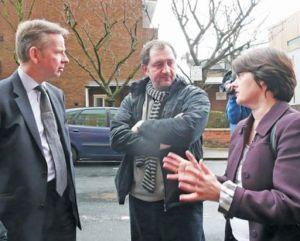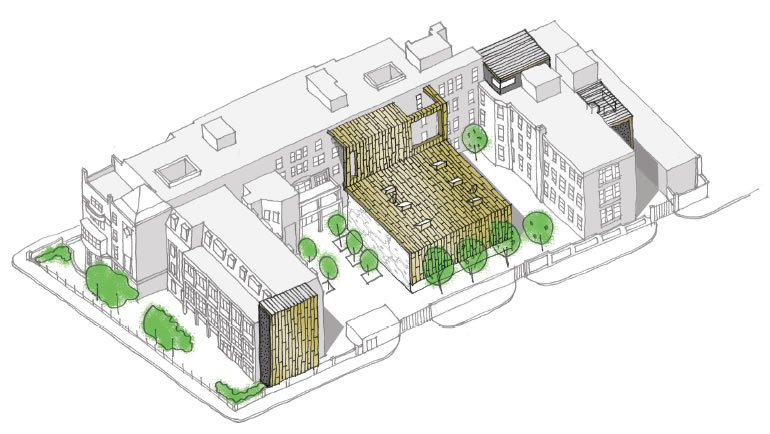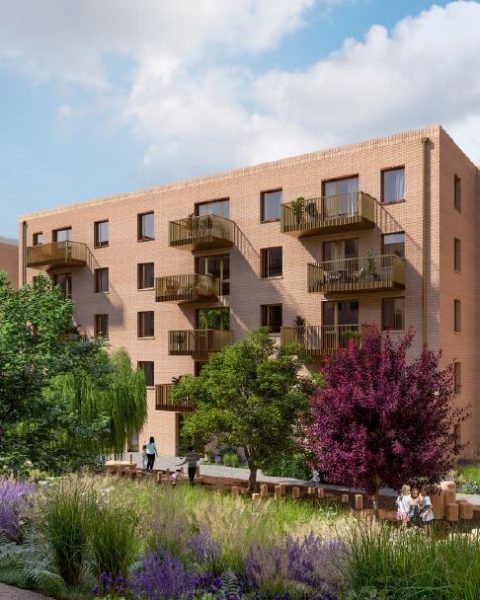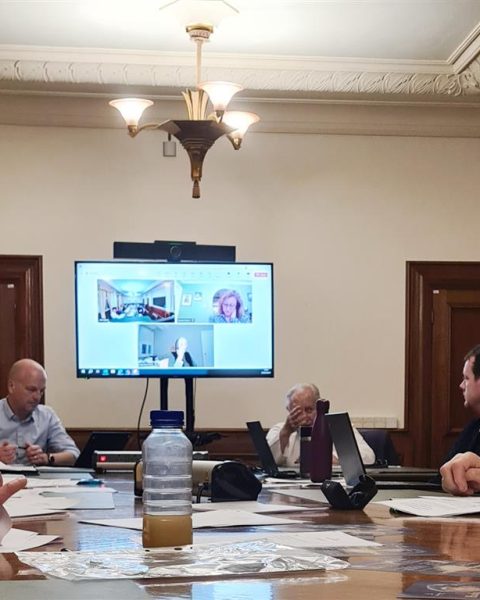Author: Cyril Richert
The Education and Children’s Services Overview and Scrutiny Committee met on Tuesday, 21st September, 2010 and had on its agenda to consider report by the Director Children’s Services on a proposal by ARK Academies with the Neighbourhood Schools Campaign (NSC) to establish a Free School on the Bolingbroke Hospital site.
It comes after the St George’s trust organised an exhibition for their pre-consultation on proposals for new flats and health facilities on site.
Evidence of demand for a new secondary school
In the report considered by the Committee, ARK’s proposal states that 2,000 parents have signed the NSC’s petition supporting the creation of a new school in the Northcote ward. It argues that:
- Wandsworth has one of the lowest proportions (48%) of parents being offered their first choice of school in London (probably not only “due to the success of local schools” as added in the Leader of the Council’s letter, although families do indeed target Wandsworth). In 2009, 27.8% of Wandsworth secondary pupils went to another authority to attend school.
- Seven of the Borough’s 11 secondary schools are oversubscribed. Of the four that have surplus places, two are Catholic schools (John Paul II and Salesian – where non-Catholics are not offered places on religious grounds) and the remaining have relatively low GCSE results (Elliott is currently in special measures).
Only 27% of the 500 or so 11-15 year olds resident in Northcote ward currently attend Wandsworth maintained secondary schools. Except Burntwood, a single sex girl’s school which has 44 in the Northcote ward, the nearest schools to the Bolingbroke site, Battersea Park and Chestnut Grove, only have five and six of their current pupils (May 2010 school census) living in the Northcote ward, so they do not seem significantly at risk of losing pupils. Southfields Community College has 18 pupils living in the ward but, as an outstanding school in Ofsted inspections, is again unlikely to lose many pupils. Elliott School has ten pupils living in the ward and would almost certainly lose some to the Free School. The Free School would probably take some pressure off Graveney School, which is currently heavily oversubscribed.
The Free School proposal
The paper explained with details (5 page report but with 17 page appendix including the proposal form) the aim and information of the proposal by ARK to run a Free School [1]. The NSC has been campaigning for a non-selective, non-denominational school since 2009. In May 2010, the NSC chose ARK [2], to set up and operate the new school. In the proposal form they explain the aim and objective of the school:
The NSC’s aim is to create a small, socially inclusive neighbourhood secondary school, where teaching and learning enable pupils to become knowledgeable, confident, competent and self reliant citizens, fully prepared for adult life and the world of work. The school and parents will work in partnership to ensure every child fulfils their potential.
The NSC and ARK share a belief in high aspirations, high motivation and high achievement in and for all pupils, irrespective of their start in life. In particular, we aim to ensure that every pupil makes enough progress by age 18 to have real options: to move into higher education or follow the career path of their choice.
The school will be a five form entry secondary school, ideally located on the site of the disused Bolingbroke Hospital at the edge of Wandsworth Common. It will be non-selective and non-denominational, open to all local children. After prioritising children with special educational needs and children in public care, straight-line distance will probably be the main admissions criterion.
The school will be part of the network of ARK schools sharing curriculum, teaching and learning practices, pastoral practices and administrative services. All ARK schools operate within one academy Trust, ARK Academies, with a local governing body for each school and a single ARK Academies board of trustees. To achieve our ambitious aim, ARK will bring together experienced teachers and education professionals to deliver a rigorous educational model which results in an outstanding local school. The key principles of this model are:
- High expectations for: -Pupil achievement and behaviour; -Staff professionalism, skill and commitment
- Rigorous and engaging lessons
- Respect for teachers and a calm, orderly environment
- Continuing assessment and responsive support for each pupil
- Depth before breadth: an emphasis on literacy and maths
- More time for learning
- Larger schools broken down into smaller units: schools-within-schools
- Aspirational identity
- Motivational culture
- Strong partnership with parents
The school they propose would have five forms of entry of 150 pupils and a sixth form of 200.
Choice of site and admission policy
The NSC has identified the site of the former Bolingbroke hospital as the potential site for the academy (Bolingbroke Grove, London SW11 6HN).
According to the report presented before the Committee, Partnerships for Schools (PfS – the non-departmental public body set up to deliver Building Schools for the Future – BSF) has identified the Eltrincham Street depot (Clapham Junction train depot?) as a possible option, although is not the NSC’s preferred site.
It is proposed that the school open in temporary accommodation (if this can be provided) as early as September 2011. The school would then move into its permanent buildings in September 2013.
Temporary accommodation could potentially be provided in demountables on site or through phased occupation of the Bolingbroke site. The preferred option, however, would be to open the school at the Vines School site, as suggested by PfS.
The CJAG visitor will remember that this is also this location that is proposed to welcome the extension of Belleville primary school next year. Therefore the Council said that an opening in 2012 on the Bolingbroke site as a more realistic target (in addition an opening as early as September 2011 can only be achieved by a change in legislation as currently application form must be made by 31 October 2010).
The Council also understands that the NSC is proposing straight-line distance to be the main admissions criterion. It recommends to use the shortest walking route with street lighting (as other schools in the borough) although the use of Wandsworth Common beside could be a shorter path.
Cost of refurbishment
The disused Bolingbroke hospital is owned by the NHS and located in the centre of the ‘secondary gap’ in Wandsworth. It is a listed building, which would require significant refurbishment to operate as a school.
The NSC commissioned HKS Architects to undertake some feasibility work and estimated remodelling and refurbishment costs in the region of £20m
PfS have carried out their own studies and indicated costs in the region of £11.35m for 4 form of entry (FE) with a fifth form of 150 with a total area of 7275m2 (less than the area which would be required to meet the DfE BB98 guidelines). For a 5FE school with a sixth form of 200, costs are estimated at £14.13m with a total area of 8875m2. There is some new build in both options to create an indoor sports facility and multi-purpose hall.
Therefore the Council recommends that the school should be 4FE in size with a 150 place sixth form only (but leaves the door open for the NSC to submit further specific evidence on the source and scale of demand for new places), thus reducing the cost. However further studies will have to be made to estimated properly the overall cost in any case.
Priority purchase possible but funding unconfirmed
In his letter (appendix to the report), Councillor Edward Lister said that the Borough Valuer has been progressing discussions with the NHS St George’s Trust to investigate the possibility of a ‘priority purchase’ under the provisions of the Estate Code.
The Council would acquire the site on the basis that the costs of any Priority Purchase would be met in full by the government. Priority purchase would be undertaken on the basis that the Council would acquire the site for educational purposes and the site would continue to be used for the public benefit. Any Priority Purchase by the Council would need to be met from government grant which is currently unconfirmed, as noted by the Director of Finance (comment 16 page 4).
It confirms what David Canzini said to me when we met at the exhibition on September 11th: although Wandsworth Council made a proposal to buy the site, they have not shown any money commitment and therefore the Trust faces the obligation to provide a plan B, should the funding promised by the Council not be existent/sufficient.
According to the leader of the Council, the NHS Trust has been asked to provide information on their valuer’s opinion of the open market value of the site and on the conversion design, planning and other assumptions on which that valuation is based. This information has been promised and is awaited.
In the aim to maximize the price of the site and to establish its market value, St George’s Trust (SGT) and the Wandsworth Primary Care Trust (PCT) have put forward a plan to transform the Bolingbroke buildings into high standard residential. Their purpose is to provide the Council with the best value of the site, while maintaining their obligation to provide a plan B should the public authority be unable to provide funding.
By acquiring the site for the school with a Priority Purchaser status, rather than ARK or NSC trying to acquire it themselves, the Council prevent the Trust from openly marketing the property. The transaction would be on a negotiated basis at market value, the same as if the Council were to compulsory purchase the property but without a defined Lands Tribunal procedure for resolving any disputes over the price or any binding obligation on the Trust to sell at all and just the Trust’s urgent need for capital driving the transaction. The Priority Purchaser status can therefore avoid the uncertainty of the transaction being exposed to the risks of competitive bidding in the open market but is, however, susceptible to any delays by the Trust who also may seek ways to avoid agreeing the Council’s status as Priority Purchaser if they consider this might not maximise the receipt for the Trust.
Although it is unlikely to cause extended delay as SGT needs the sale to be completed within the financial year (31 March 2011) in order to raise money to enhance services in St Georges Hospital (Tooting).
Jane Ellison and the school campaign
Jane Ellison, MP for Battersea, distributed her latest leaflet this week focused on the Clapham Junction area.
“Jane continues to work with the local Neighbourhood School Campaign and the Council to progress the development of a ‘free school’ on the former Bolingbroke hospital site. She has raised the issue regularly with Secretary of State Michael Gove, who visited Battersea twice during the run-up to the election.”
 Indeed Jane Ellison participated to a debate on Free School Policy on House of Commons debates, 21 June 2010 where she raised the attention of Michael Gove on the Neighbourhood School Campaign.
Indeed Jane Ellison participated to a debate on Free School Policy on House of Commons debates, 21 June 2010 where she raised the attention of Michael Gove on the Neighbourhood School Campaign.
“Jane Ellison (Battersea) (Con): Has the Secretary of State had a chance to meet people from the neighbourhood school campaign in my constituency, who have already made considerable progress towards the establishment of a new secondary school in Wandsworth-a campaign that I note that the shadow Secretary of State supported prior to the election?
Michael Gove: I thank my hon. Friend for that question. I have had an opportunity to meet that idealistic group of parents, and others in Wandsworth. I want to pay tribute to Mr Ron Rooney, Mr Jon De Maria and the other members of the group, who have done so much. My hon. Friend is right: the right hon. Gentleman was warm towards that group when he was in government. Warmth towards the group has also been extended by the local authority-Wandsworth borough council-and its leader, Edward Lister. Like so many other local authorities, it has warmly welcomed this initiative to introduce pluralism, diversity and high quality in the state education system.”
Translating Jane Ellison’s contribution in straight forward English, it means: Did you have time to meet again with the NSC since you are SoS for Education, as you showed interest during campaign for the May election (photo)? And the answer is Yes.
[1] As defined by the current government, “Free schools are all-ability schools set up in response to parental demand”. In all other respects, Free Schools are academies and they have the same statutory basis as academies. They are thus independent schools and have to comply with Independent School legislation and meet the Independent School Standards (subject to the Ofsted inspections). But Free Schools do not have to comply with National Curriculum although they are required to have a broad and balanced curriculum and to comply with any national testing regime.
The main difference between Free Schools and Academies will be in their establishment. The Academies Act allows maintained schools to convert to academy status but these schools will not be able to choose the Free School route to becoming an academy. Registered independent schools can apply to convert to free schools. The DfE envisages that most free schools will be ‘brand-new schools, set up by charities, universities, business, community or faith groups, teachers and groups of parents where there is parental demand’.
[2] It would have been interesting to have a public explanation on the choice and the possibility to compare openly the different competitors, but it seems that the decision was taken behind closed doors.













